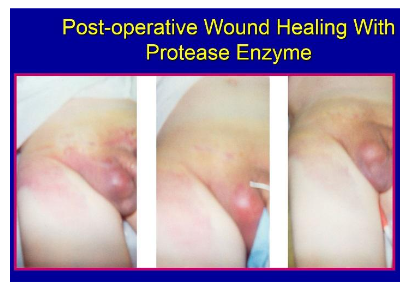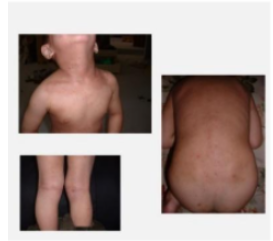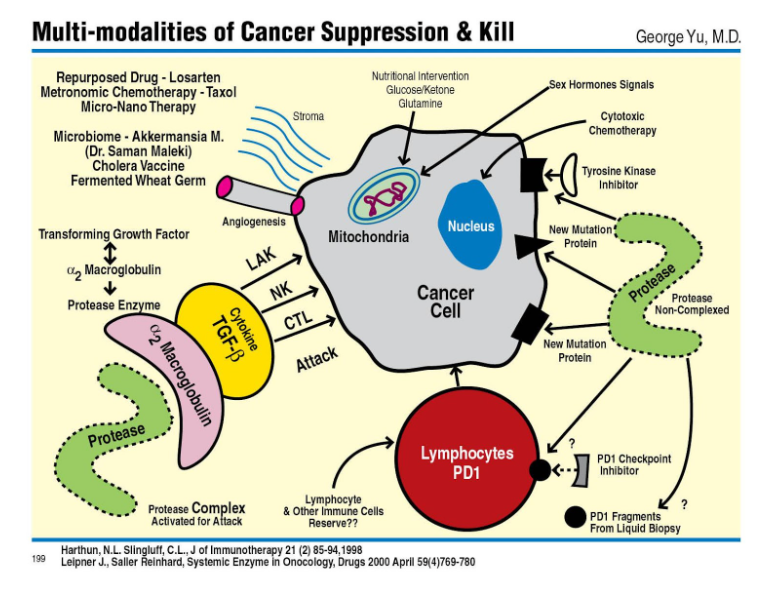
As a past surgeon for thirty seven years (37), I am a doctor who worked in the trenches in missionary work, in the operating rooms...

“The Phenomenon Looking For a Reason”
George Yu 2/11/23
The Protease Enzyme Approach has been historically an effective cancer treatment first started by Dr. William D. Kelley

First developed by Dr. William D. Kelley, the Protease Enzyme Protocol has historically been shown to be an effective cancer treatment. Dr. Kelley formulated this protocol and cured himself of pancreatic cancer.
Two of his students, Nutritionist Pamela McDougle of Idaho and the late Nick Gonzales, MD, of New York City, resurrected this old form of cancer treatment and have found it especially effective in pancreatic cancer. Pamela has been in practice since the 1990s and has seen over 5000 patients using protease enzymes. The late Dr. Gonzales championed this methodology and collaborated with Columbia University Medical Center, in a failed attempt to conduct a formal clinical study evaluating the protocol.
Pamela McDougle, a nutritionist of Idaho and the late Nick Gonzales, MD of New York City were students of Dr. William Kelley. Dr. Kelley formulated his protocol and cured himself of pancreatic cancer many years prior.
Pamela has been in practice since the 1990s to the present and has seen over 5000 patients. Dr. Gonzales collaborated with Columbia University Medical Center and attempted to do a formal clinical study. With that history we are still puzzled why this program has been able to successfully cure some cancers. Since 1981 as a pelvic oncological surgeon for thirty (30) years, I have witnessed some patients who are still alive free of disease.
At present Pamela uses porcine (pig) pharmaceutical grade pancreatic proteases with a high concentration of bovine (cow) Chymotrypsin animal enzyme. The plant fungal enzymes are not potent enough to achieve the same clinical therapeutic results.
My Experience with Strong Japanese Plant Fungal Protease Enzymes
As a surgeon I have learned from cosmetic plastic surgeons that plant fungal protease enzymes can eradicate the “black and blue” or ecchymoses of blood and proteinaceous debris under the skin and internally after surgery. I have explained this as a “Pacman” digesting residual red blood cells, protein and debris within the skin and other internal organs.
For over thirty years I used this method to clear up the residual tissue debris from surgery in the kidney, abdomen, pelvis and groin areas for patients.

By adding lactase enzyme to the diet allowed people who became milk intolerant as adults to drink milk as when they were children.
We have used the plant enzymes to correct unknown food allergy such as seen below with a young boy with skin eruptions, rash with severe itching which was gradually corrected by ingesting plant enzymes with meals. The protease enzymes seem to work within the intestinal bowels and even cross into the blood and lymphatic system to digest and metabolize foreign proteins leading to food intolerance and allergies





Effectiveness Protease Enzyme as generalized treatment for all types of cancers
Though not fully understanding the rationale of enzyme treatment, I have seen cures using this form of treatment of very resistant and aggressive cancers such as pancreatic, melanoma, and sarcomas more than our standard cancer treatments.
With the emerging science of “cancer treatment resistance” and cancer mutations leading transcription of new proteins promoting cancer growths, and the development of monoclonal antibodies to target these new proteins, we now can intelligently guess why these protease work in cancer treatments -“phenomena looking for a reason”.
Birth of Immunotherapy targeting the immune system rather than directly targeting cancer cells

Our analysis is based on the pioneering work by James Allison (CTLA-4) of USA and Tasuku Honjo (cell death 1 (PD-1), of Japan. Both won the Nobel Prize for immunotherapy.
Having developed an antibody that binds to CTLA-4 protein and blocks its function, Allison began investigating whether CTLA-4 blockade could disengage the T-cell brake and unleash the immune system to attack cancer cells. Allison's team performed the first experiments at the end of 1994, and the results were "spectacular,"- commented Nobel organization. Mice with cancer were cured with an anti-CTLA-4 agent.
Promising clinical results soon followed from several groups, and in 2010, a key clinical trial showed striking effects in patients with advanced melanoma. "In several patients signs of remaining cancer disappeared. Such remarkable results had never been seen before in this patient group," noted by the Nobel organization.
In 1992, Tasuku Honjo discovered programmed cell death 1 (PD-1), another protein expressed on the surface of T cells. In a series of experiments, Honjo showed that PD-1 (like CTLA-4) also functions as a T-cell brake but operates by a different mechanism. In 2012, a pivotal study demonstrated clear efficacy in the treatment of patients with different types of cancer. "Results were dramatic, leading to long-term remission and possible cure in several patients with metastatic cancer, a condition that had previously been considered essentially untreatable," noted by the Nobel organization.
The pioneering work of Allison and Honjo on immune checkpoint inhibitor therapy led to the development of several drugs, including ipilimumab (Yervoy, Bristol-Myers Squibb), the first of the checkpoint inhibitors, and the PD-1 inhibitors nivolumab (Opdivo, Bristol-Myers Squibb) and pembrolizumab (Keytruda, Merck & Co).
Many checkpoint therapy trials are currently underway against most types of cancer, and new checkpoint proteins are being tested as targets.
Immunotherapy marks an entirely different way of treating cancer — by targeting the immune system, not the tumor itself," according to the report.
In 2013, "clinical trials have cemented [cancer immunology's] potential in patients and swayed even the skeptics. “A corner has been turned and we won't be going back."
And now TCGA Total Cancer Genome Atlas, discovered cancers’ frequent genome mutations leading us to the present many Targeted Therapy for cancers. The circulating cancer stem cells and the development of using liquid biopsies from blood will in the future make more discoveries of cancer new mutations.
The use of Monoclonal antibody against these new proteins and smaller protein amino peptides is the basis of the explosion of targeting monoclonal antibodies against these new protein mutations.
Cancer cells mutate to adapt to adverse environment which leads to creation of a new proteins or smaller peptides which resist cell death or apoptosis. These mutated cancers produce new proteins leading to “treatment resistance” as seen in traditional cytotoxic agents’ therapy an even newer targeted treatments such as Enheurtu program for breast cancers.
At present we target a mutated cancer gene with a new protein using a designed “Monoclonal Antibody” alone or attached to drugs. The clinical results are sometimes dramatic until a new mutation with a new protein is created within 6-8 months.
A Practical Approach Using Proteases Enzymes to Attack All Newer Proteins from Cancer Ongoing Mutations – A Phenomenon Searching for a Reason
Our clinical practice focuses on a multiple prong approach as in a “War analogy “ using many methods to weaken the cancer growths. We use.
1) metabolic mitochondrial approach, especially if the PET/ CAT scan shows high uptake of flouro Deoxy glucose sugar, using CRONK (calorie restricted optimal nutrition ketosis),
2) use of metabolic blocking agents as Dichloroacetate, Deoxy Glucose, Palladium Lipoic Acid and 3 Bromopyruvate etc.,
3) “Repurposed drugs” such as Metformin, Doxycycline, Mebendazole and Fenbendazole and anti-angiogenic Losartan etc.
4) natural polyphenols Curcumin, Quercetin (a similar effect to Dasatinib of senile cell death) and Melatonin, natural killer cell hormone etc. ,
5) and use of “Metronomic” low dose constant chemotherapy and ultra-low concentration at 10⁻³ 10⁻⁵ 10⁻⁹ and even 10⁻²¹ MicroNano therapy effecting the cancer microenvironment as the stromal tissues, angiogenesis of proliferating cancer mitosis without disrupting and injuring the immune white cells, red blood and visceral organs such as Taxol (Henkin).
Good reference Wang J , Henkin J Anti-Cancer Drugs 14:13–19 2003
6) targeted therapy with less adverse effects.
The Analogy of Fighting Cancer as a War Requires Many Different Ways to Attack from Food Fuel Starvation, Deprivation of Water, Deprivation of Ammunition, Bombing Transport and Communications, Fighting in Winter, and lastly Sending in the Troops and Bombs. George Yu MD
Why Use Protease Intervention as Another Weapon in Ever Changing Mutating Cancer Heterogeneity
The reason we resort to protease enzyme treatment is the problem with cancer heterogeneity meaning that cancer cells in the same tumor carry different cell antigen proteins on the surface therefore hard to identify all and the changing mutating cancer producing new proteins. The targeting treatment often lasts for 3,6,8 months and a new mutation occurs with recurrent cancer growth.
“The analogy like chemically weeding the lawn grass, but the newer breeds grow faster and are resistant to your herbicides”.
The Likely Mechanisms of the Protease Enzyme Protocol
The proteases enzymes may have the ability to indiscriminately “denature, metabolize, and change all kinds of proteins or peptide configurations” thus blocking these proteins and stop cancer progression and growth. I can only intelligently guess why these enzyme protease therapy has such successful outcomes against aggressive cancers. There is an excellent reference to share with you. The alternative is to use these strong proteases that destroy all new proteins from mutations and will not have less adverse effects to your own body.
Journal of Immunotherapy Vol 2, 1998 Activated Macroglobulin reverses Immunosuppressive activity in human breast cancer cell conditioned medium by selectively neutralizing Transforming Growth Factor Beta in presence of Interleukin-2 -Harthun NL, Slingluff CL

The increasing use of liquid biopsies are also showing cancer fragments with and without the new mutation proteins and systemic proteases in the blood stream may be able to denature these aberrant protein cancer complexes.
The key is that these powerful protease enzymes can cross the intestinal blood barrier and not harmful to the host body but seems to have a indiscriminate ability to digest or denature foreign proteins as I have witnessed in my post operative surgical experience with dead and residual protein and blood fragments as a “Pac-man” effect on wounds and ecchymoses.